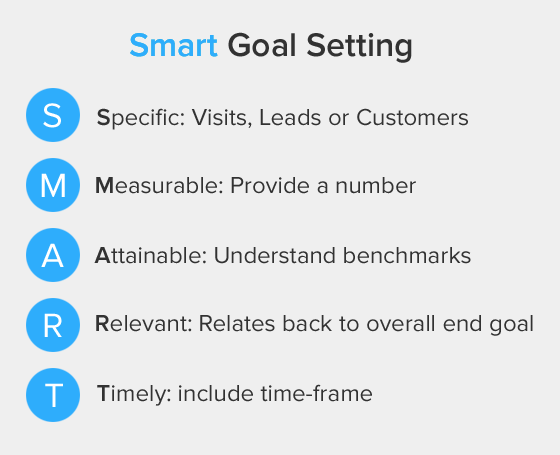We’re told from a young age the importance of setting personal goals for the future. How having goals will help us achieve greater things. But, goals aren’t just for personal life, they’re critical for a business to succeed.
Setting SMART goals is the most effective tool for accomplishing objectives in the corporate world. It brings structure and trackability into your business goals. Creating SMART goals ensures your team and/or clients understand the objective of a campaign, how it’s measured and when it will be completed.

This type of goal can be used by anyone, anywhere, without the need of any particular tools or training (other than understanding where to find data).
Throughout this blog post we will take a broad business goal and make it SMART.
The broad example is:
To transform this broad goal, we need to understand the five elements of a SMART goal.
S
Specific
What exactly are you looking to achieve? The more specific your description is, the more likely you’ll accomplish exactly what you set out to do. Be intentional with your goal setting and ask yourself the following:
- What exactly do I want to achieve?
- Why do I want to achieve this goal?
- How can I achieve this?
- When will I find time for this?
- When is the deadline for the goal?
- Who will help me accomplish this goal?
- What are the limitations I may face?
A good start to a SMARTer version of the goal above would look like this:
This shows exactly what the goal is meant to accomplish because it is now specific.
M
Measurable
A goal needs to be measurable in order for you to know if you succeeded or failed, and by how much. You’ll need concrete evidence and data to backup your goals.
You can use Google Analytics, your CRM or any other reliable data you can access to research your company’s past data. Use this data to determine the numbers you’ll measure your success against.
We can improve our example goal by adding a number goal:
This goal provides historic data showing on average the company has 100 online leads a month and Macie wants to bump that to 110.
A
Attainable

Are you being reasonable and realistic with your goal setting? Looking at your historic data is the best place to start, but there are several other elements to consider. Take time to contemplate the effort, time, costs, resources, abilities and anything else that could be needed to accomplish your goal within the desired timeframe.
Take time to contemplate the effort, time, costs, resources, abilities and anything else that could be needed to accomplish your goal within the desired timeframe.
If you jump in prematurely, you could be setting yourself up for disaster and end up wasting time and money on poor results.
It’s crucial to determine the right percentage to increase your goal by. Macie wants to improve leads by 10%. She decided on 10% because anything higher would be too ambitious and probably not attainable right now.
The importance of being able to accomplish a goal is vital when setting goals for yourself or clients. The goal is to motivate those working towards this goal. If you’re unable to achieve the goal, consider what it would take to make it attainable.
R
Relevant
 Before kick starting your goal, take a second to ensure it’s relevant to what your business is trying to accomplish right now.
Before kick starting your goal, take a second to ensure it’s relevant to what your business is trying to accomplish right now.
Some questions you should be asking are:
- What’s the objective behind this goal?
- Will this goal help achieve that objective?
This specific SMART goal should relate back to your overall business objective.
The SMART goal example we’ve been creating is relevant because Marketing Macie’s overall objective is to grow her business revenue. Increasing her company’s online leads will likely result in more customers, and more revenue.
T
Timely
Without a timely end date, a goal can easily drag on or even die off, since no one is accountable to accomplish it by a certain date. A good SMART goal should create a sense of urgency, while being realistic.
We can improve our example goal by adding a deadline:
This goal now has the five elements of a good SMART goal. Marketing Macie is ready to work towards her goal of increasing online leads.
Staying on track

Put a system in place so you’re reviewing your SMART goals regularly. It’s beneficial to know how your goal is doing at any given time.
Goal setting, however, isn’t “one size fits all”. The way you decide, create and review goals will be different than the company across the street. Take into consideration the information found in this blog post and begin your company’s journey to creating effective business goals.
Roketto Team
Who the heck is "Roketto Team"? Great question! We use this authorship from time to time for guest writers and previous authors are no longer affiliated with the Roketto brand. What about the cute little rabbit in the Roketto Team avatar? That's Piko, our loveable, space travelling mascot. If this is your first time seeing him, don't worry, it won't be your last. He likes to turn up throughout Roketto's website and content, always looking to help our audience with their marketing needs.











![[Download our Free SMART Goals Template]](https://no-cache.hubspot.com/cta/default/2886534/7c250b00-e940-4426-8716-cbaba3ccd180.png)


2.png)
2.png)









